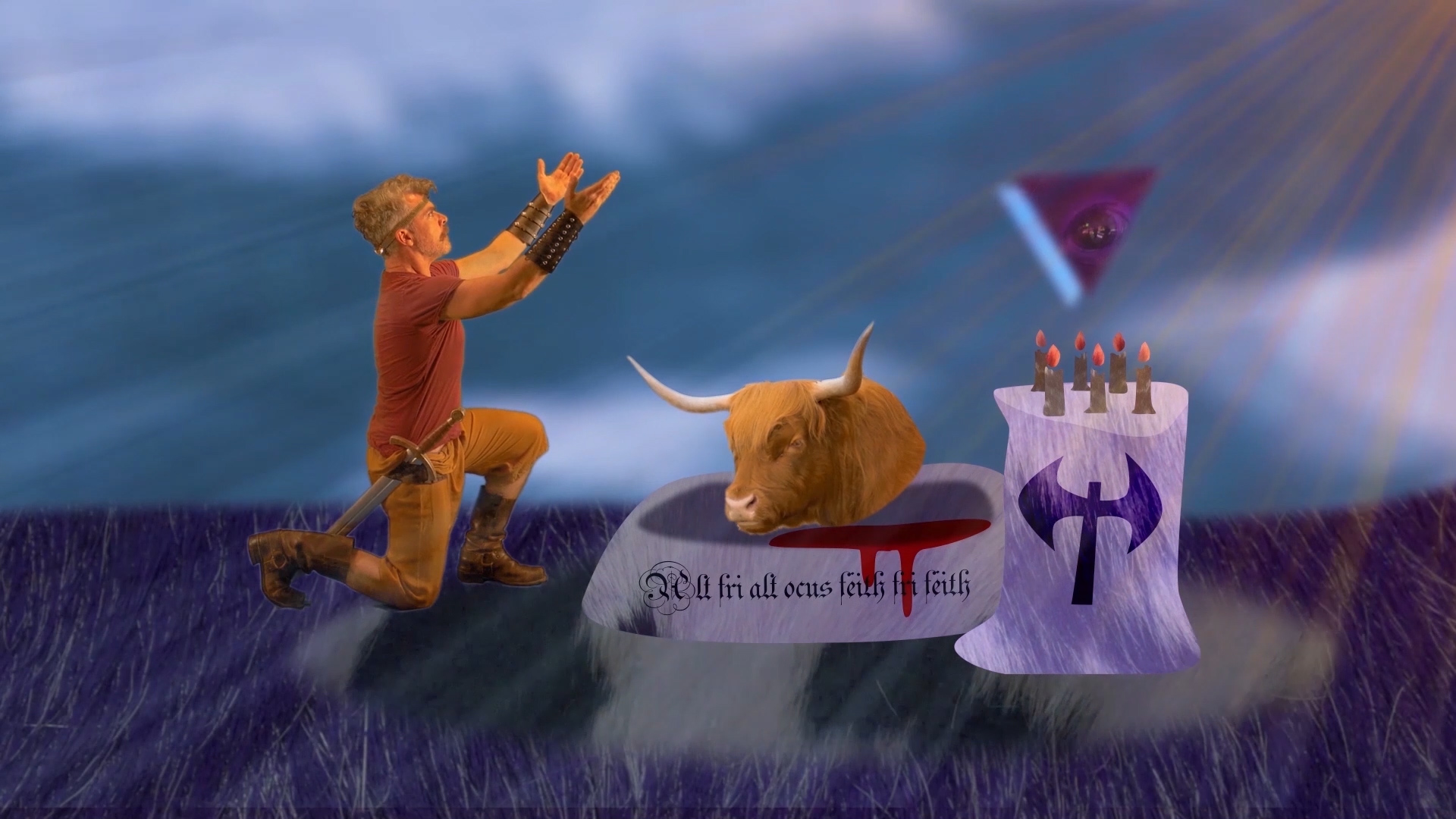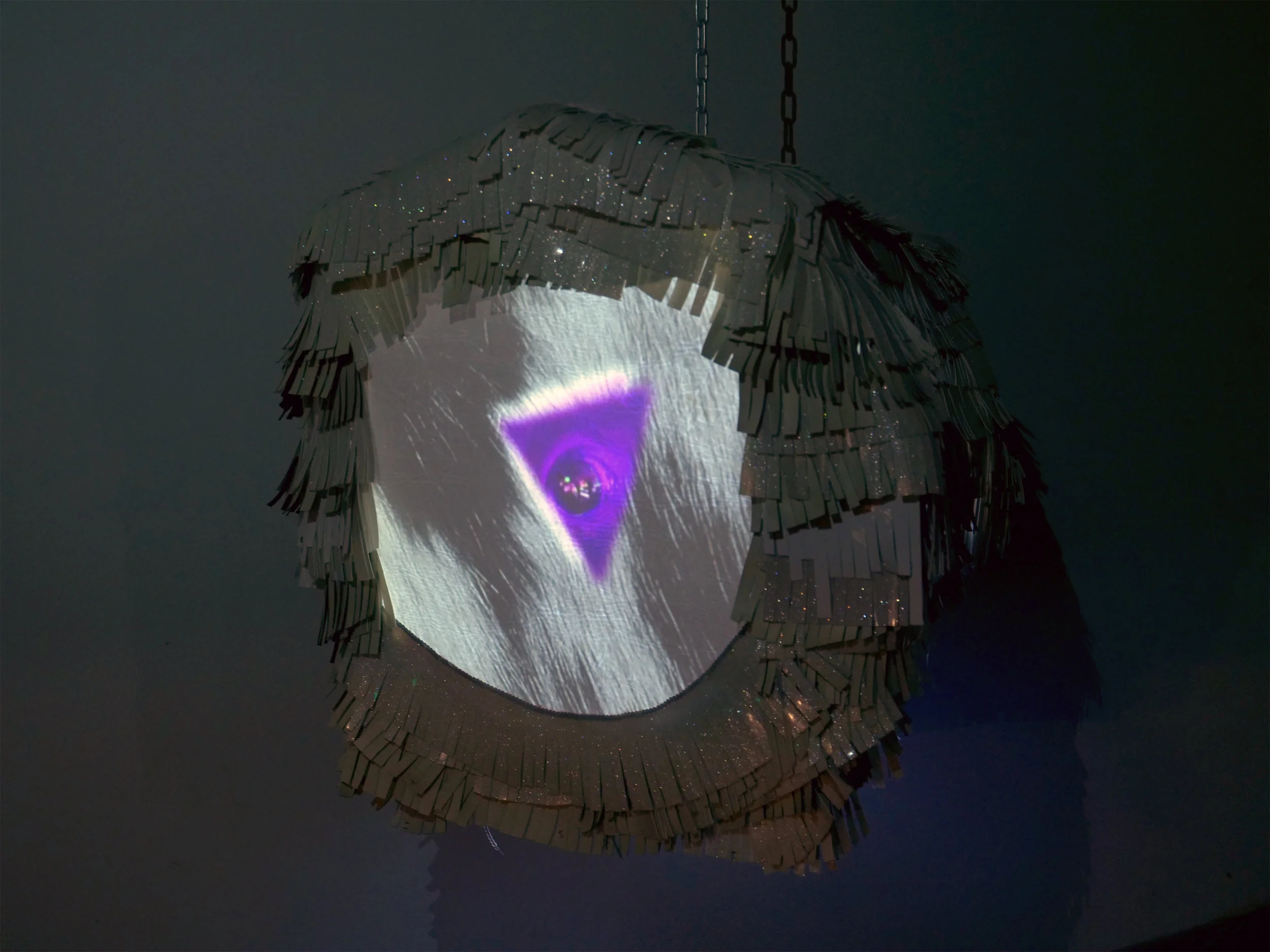
Calfskin
Solo exhibition at Telematic in San Francisco
October 27 - December 1
From the exhibition description: “This exhibition is a rumination on Telematic’s location which was once Stompers Boots, a staple of the SOMA leather community… Rhoades queers the species divide and reflects on the history of subjugation and abjection that animals, queer humans, and human-animal hybrids have shared.”

Cattle History
Featuring actor and Taurus, Kevin Clarke

Hole Scroll

Baby
(Front view)
Video sculpture (rear projection)
Made with chain, pleather, wood, metal, sequins, thread, other things
2.5’ x 2’ x 2.5’

Baby
(Side view)
Video sculpture (rear projection)
Made with chain, pleather, wood, metal, sequins, thread, other things
2.5’ x 2’ x 2.5’

Mommy
Video sculpture (rear projection)
Made with chain, pleather, wood, metal, sequins, thread, other things
3.5’ x 2’ x 3’

Mares of Magnesia
Solo exhibition at Royal NoneSuch Gallery
May 12 - July 1st 2018
Exhibition Statement:
Back in the day, a Greek king named Ixion murdered his father-in-law. Society said, 'Whoa! That’s way out of line!' So he was left to wander without a country. Zeus felt bad for him and brought him to Mount Olympus for dinner. Sure enough, Ixion started sexually harassing Zeus’s wife Hera. Zeus manifested a cloud woman identical to Hera and sent her to Ixion to catch him being a total asshole. Once Ixion had sex with the cloud woman, Zeus said, 'Got ya! Now I’m tying you to a wheel that will spin for all eternity!' Cloud woman became pregnant with a baby, Centaurus, who was part horse, part human. The gods were disgusted and sent Centaurus down to the mortal realm. He mated with the female horses in the Greek region of Magnesia, and their progeny were the centaurs. Half man, half beast, the centaurs were said to be brash, violent, and impulsive, just like their terrible ancestor, Ixion.
Why?! Why are all the centaurs made to look this way? Like many mythical tales, the story of the centaurs served to glorify the conquering tribe and dehumanize the conquered, depicting them as subhuman beasts. The myth of the centaurs has its roots in the political conflicts that occurred in Thessaly, Greece, before the first century BCE. The Lapiths, the mythical people that drove out the centaurs, are based on an actual tribe in Thessaly, which subjugated and displaced the other tribes in the region. This vanquishing tribe perpetuated these stories, depicting the Lapiths as heroes and the tribes they conquered as literal savage animals. The centaur story is one of nationalism and conquest.
The Mares of Magnesia exhibition includes four rocking sculptures with embedded videos and a wall painting inspired by Greek landscape paintings. Audience members must mount the wooden upholstered forms, physically enacting a series of vulnerable horse-like positions. As viewers become active participants in the mythological relationship between humans, the centaurs, and their horse mothers, the mares of Magnesia, they are invited to somatically reimagine a hybrid inter-species that exists beyond the hero/monster narrative.

Mares of Magnesia: Rocker #4 (Centaur Stories)
Part of a series of four videos each installed within a rideable sculpture.








Centaur Screen Test 2
Calfskin
Solo exhibition at Telematic in San Francisco
October 27 - December 1
From the exhibition description: “This exhibition is a rumination on Telematic’s location which was once Stompers Boots, a staple of the SOMA leather community… Rhoades queers the species divide and reflects on the history of subjugation and abjection that animals, queer humans, and human-animal hybrids have shared.”
Cattle History
Featuring actor and Taurus, Kevin Clarke
Hole Scroll
Baby
(Front view)
Video sculpture (rear projection)
Made with chain, pleather, wood, metal, sequins, thread, other things
2.5’ x 2’ x 2.5’
Baby
(Side view)
Video sculpture (rear projection)
Made with chain, pleather, wood, metal, sequins, thread, other things
2.5’ x 2’ x 2.5’
Mommy
Video sculpture (rear projection)
Made with chain, pleather, wood, metal, sequins, thread, other things
3.5’ x 2’ x 3’
Mares of Magnesia
Solo exhibition at Royal NoneSuch Gallery
May 12 - July 1st 2018
Exhibition Statement:
Back in the day, a Greek king named Ixion murdered his father-in-law. Society said, 'Whoa! That’s way out of line!' So he was left to wander without a country. Zeus felt bad for him and brought him to Mount Olympus for dinner. Sure enough, Ixion started sexually harassing Zeus’s wife Hera. Zeus manifested a cloud woman identical to Hera and sent her to Ixion to catch him being a total asshole. Once Ixion had sex with the cloud woman, Zeus said, 'Got ya! Now I’m tying you to a wheel that will spin for all eternity!' Cloud woman became pregnant with a baby, Centaurus, who was part horse, part human. The gods were disgusted and sent Centaurus down to the mortal realm. He mated with the female horses in the Greek region of Magnesia, and their progeny were the centaurs. Half man, half beast, the centaurs were said to be brash, violent, and impulsive, just like their terrible ancestor, Ixion.
Why?! Why are all the centaurs made to look this way? Like many mythical tales, the story of the centaurs served to glorify the conquering tribe and dehumanize the conquered, depicting them as subhuman beasts. The myth of the centaurs has its roots in the political conflicts that occurred in Thessaly, Greece, before the first century BCE. The Lapiths, the mythical people that drove out the centaurs, are based on an actual tribe in Thessaly, which subjugated and displaced the other tribes in the region. This vanquishing tribe perpetuated these stories, depicting the Lapiths as heroes and the tribes they conquered as literal savage animals. The centaur story is one of nationalism and conquest.
The Mares of Magnesia exhibition includes four rocking sculptures with embedded videos and a wall painting inspired by Greek landscape paintings. Audience members must mount the wooden upholstered forms, physically enacting a series of vulnerable horse-like positions. As viewers become active participants in the mythological relationship between humans, the centaurs, and their horse mothers, the mares of Magnesia, they are invited to somatically reimagine a hybrid inter-species that exists beyond the hero/monster narrative.
Mares of Magnesia: Rocker #4 (Centaur Stories)
Part of a series of four videos each installed within a rideable sculpture.
Centaur Screen Test 2















